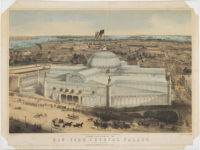As you enter the lobby of the California Institute of Tech-nology’s Graduate Aerospace Laboratories (GALCIT), your eye is drawn upward, where an amoebalike entity clings to the ceiling. It seems to be digesting the building—engulf-ing a quartet of irregularly shaped concrete columns as it oozes hun-grily down the hall. Ahead, a dramatically canted window reveals a green-hued laboratory, and cursive lettering loops halfway up the wall, then spills down onto the floor, where the department’s acronym is in-scribed in pink terrazzo. The introduction to this elite graduate school in Pasadena is baroque, brash, and functional.
The space is part of a major interior renovation to GALCIT’s Guggenheim Building by Los Angeles firm John Friedman Alice Kimm Architects (JFAK), whose eclectic design for a Santa Monica dance club was featured as a Record Interior a decade ago [record, September 1999, page 145], followed by other projects covered since.
GALCIT was founded in 1928 with a grant from Daniel Guggen-heim, an industrialist as famed for his ruthlessness running the family mining concern as for his philanthropic largesse. The school enjoyed success and status for much of the 20th century. Douglas Aircraft tested its iconic DC plane series at the young lab; President Kennedy awarded former GALCIT director Theodore von Kármán the first National Medal of Science. Over time, however, the school lost some of its prestige.
According to Ares Rosakis, Caltech’s chair of the division of en-gineering and applied sciences, the Guggenheim Building was designed to house the department’s three-story wind tunnel. When the antiquated machine was removed in 1996, the building’s structure was so under-mined that Caltech allocated money for a seismic overhaul.Rosakis, an excitable optimist, recognized architectural possibility in the void where the old apparatus had been. The three-story warren of labs, classrooms, and offices needed more than a retrofit. It needed a new identity.
JFAK’s design work began in late 2006. The firm digitally modeled the building’s existing mechanical systems and structure, which facilitated the removal of outdated components, such as defunct piping and gypsum concrete walls. Construction on the $6.4 million, 18,000-square-foot project was completed in 2008; it will be fully occupied this month.
John Friedman, FAIA, says the firm constantly looked “to eliminate arbitrariness” in its design. Which is not to say the interiors are subdued or quiet—they border on immodesty at points. The enthusiastic ornamentation mostly arose from solutions to programmatic problems and references to the school’s research. To help guide their design, he and Alice Kimm, AIA, interviewed faculty and closely studied images of the lab’s work. Their homework paid off. One can see “GALCIT’s re-search concealed artistically” in the architecture, explains Rosakis. On the lobby’s suspended ceiling, for instance, dimples and perforations are meant to allude to the work of a professor studying propulsion in octopi; the resin’s supple curves are inspired by images of gas dynamics.
The overlap of aesthetics and utility is most evident in the Kármán Conference Room. The ceiling, made of laser-cut plywood and 1⁄2-inch felt, is both an effective acoustic damper and a figurative depiction of a type of vortex discovered by the former GALCIT director.
In the same room, a beautiful glass-topped table with shallow acrylic drawers effectively doubles the surface’s display area. Floor-to ceiling display cases with mechanized shades have replaced the original concrete walls. The vitrines contain artifacts from the school’s history, including a broken blade from the old wind tunnel.
JFAK added windows to the Guggenheim’s rear facade, replaced opaque gypsum with transparent glass in the offices, and visually linked spaces whenever possible. A visitor in the lobby can observe activity in the Laboratory of Large Space Structures through a wide window and glass door; the lab is also visible from a second-story catwalk that evokes a surgery theater. In all cases, the intent was not just to increase lightness, but also “to emphasize the collaborative spirit,” says Friedman.
The net effect of JFAK’s bold design is a space that acknowledges the department’s storied past without being weighed down by it. Admin-istrators say that the building has impressed faculty and students.
Kimm seems pleasantly surprised that GALCIT let them “do these exploratory things” with three-dimensional design and BIM. “Some of it, we didn’t know would work. But that’s what they do, right?”
PeopleOwner: California Institute of Technology Architect: Personnel in architect's firm who should receive special credit: Project Architect: Claudia Kessner Project Designers: Robert McFadden, Garrett Belmont, Brendan Beachler Project Team: Pamela Schriever, Casey Hughes, Daniel Poei Engineer(s): Mechanical and Plumbing: MEDG Consulting Engineers Electrical: Pacific Engineers Group Consultant(s): Other: Graphics Consultants: Patricia Kovic and Maureen Nishikawa General contractor: Photographer(s): CAD system, project management, or other software used: Coordination: GoToMeeting |
ProductsStructural system: Windows: Aluminum: Doors: Hardware: Hinges: Ives Closers: LCN Exit devices: Von Duprin Pulls: Sargent Cabinet hardware: Häfele Interior finishes: Suspension grid: Cabinetwork and custom woodwork: Conference Room: JTI Millwork Third Floor Offices: Marina Woodcraft Paints and stains: Benjamin Moore Wallcoverings: Full height Markerboard: Contract Wallcoverings, Inc. Chalkboard &Tackboard: Tri- Best Visual Display Products Special surfacing: Floor and wall tile: Daltile Signage: ASI Modulex Furnishings Classroom and Lab Chairs: Tables: Conference Tables: Custom Design by JFAK, steel frame by The Welding Junction, acrylic top with drawers by JTI Millwork, resin top by Lightblocks Upholstery: Lighting: Plumbing: Toilet: American Standard Urinal: Kohler Add any additional building components or special equipment that made a significant contribution to this project: Steel Display Boxes: Custom Design by JFAK Felt Ceiling: Custom Design by JFAK,material 1/2" thick Wool Felt, installation by G&G Design Associates Terrazzo: Corradini Corp. Donor Wall: Custom Design by JFAK, installation by G&G Design Associates
|












Post a comment to this article
Report Abusive Comment